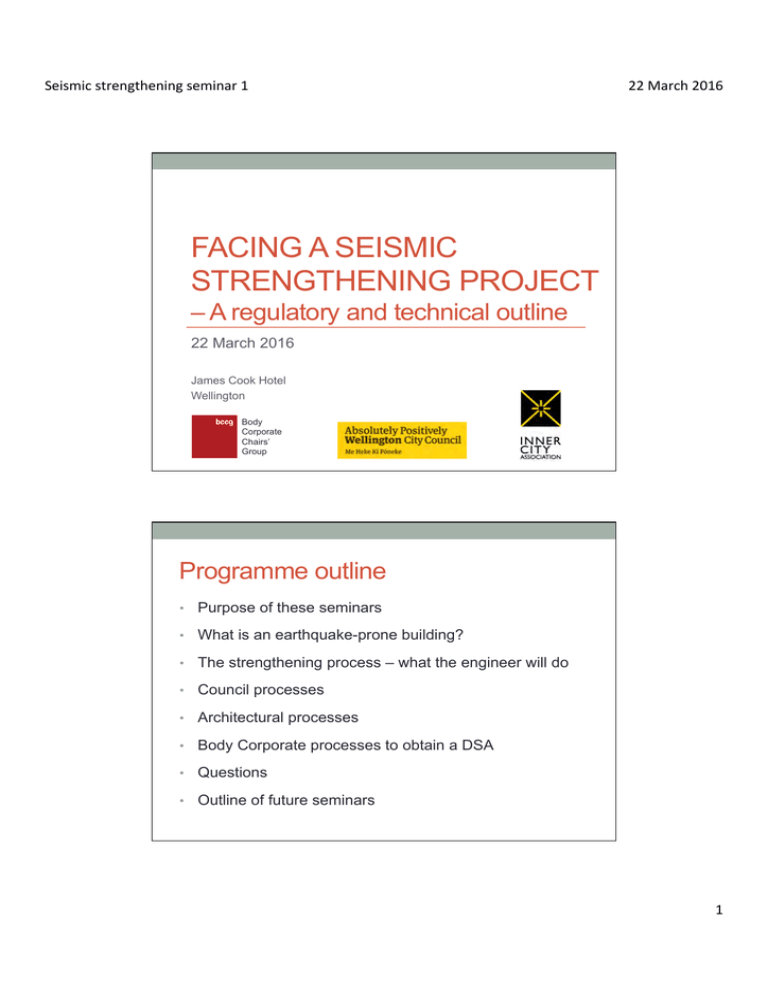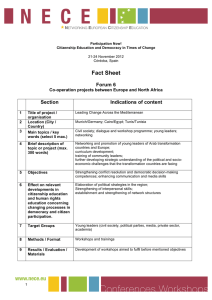a regulatory and technical outline
advertisement

Seismic strengthening seminar 1 22 March 2016 FACING A SEISMIC STRENGTHENING PROJECT – A regulatory and technical outline 22 March 2016 James Cook Hotel Wellington Body Corporate Chairs’ Group Programme outline • Purpose of these seminars • What is an earthquake-prone building? • The strengthening process – what the engineer will do • Council processes • Architectural processes • Body Corporate processes to obtain a DSA • Questions • Outline of future seminars 1 Seismic strengthening seminar 1 22 March 2016 “I have an earthquake prone building – what does this mean for me?” • Current legislation and Bill • Council powers and responsibilities including strategic and high volume routes under the Bill • Future regulations including new Methodology • What happens when the Act changes? • What is the impact on existing s124 notices? • What happens when the Building Code changes sometime in the future? 2 Earthquake Resilience Seminar 1 Notes: Wellington City Council presentation. UPDATE ON LEGISLATION The EQP Bill is entering the finals stages of being confirmed by Parliament. To date it has received near unanimous support from all political parties. It is hoped it will be passed by the end of May 2016. Once the Bill is confirmed by Parliament, the legislation allows up to 2 years before it will be implemented. This time has been allowed so that the Ministry of Building Innovation and Employment (MBIE) can develop the regulations that will support the legislation. At this point in time, it’s possible the legislation may take effect from April 2017. The new legislation is very similar to the Wellington City Councils existing EQP Building Policy, subject to the following: • Maximum 15 years for an EQP notice. • Proposal to introduce a shorter timeframe for EQP buildings located on high traffic or priority routes. These routes are yet to be defined by the MBIE regulations. At this stage the draft legislation refers to a maximum timeframe of 7 years for buildings located on priority routes. o Draft legislation will require councils to consult on “high traffic routes” proposal. Once the legislation takes effect, at this stage the major change for EQP buildings in the Wellington City Council area will be: • Maximum timeframe for an EQP notice is 15 years. This means that any existing notice that has more than 15 years left to run will be reduced back to the 15 year timeframe. COUNCIL PROCEDURES Once an EQP notice has been issued the owner(s) of the building will have until the expiration date on the EQP notice to either strengthen or demolish the building. If the work isn’t done and the EQP notice expires, the local council will have the ability to require the building to be closed. As well as closing a building with an expired EQP notice, a council can also seek a court order to undertake strengthening work. However, any costs incurred by the council can be passed back to the owner(s). If it looks like you may not get the building strengthened in time, come and talk to the council. We are here to work with you to get this resolved and would prefer not to have to close a building. Building and resource consent If you’re undertaking strengthening work the owner will need to apply for a building consent. You may also need a resource consent. This will depend on the location of the building and also if it’s a heritage building. Before you go too far into developing a solution for your building come and talk to officers to ensure they agree (in principle) with what is proposed. The aim is to ensure owners don’t waste money on consultants and designs that could require rework due to the proposed solutions not meeting council requirements. As well as engaging a structural engineer and architect to work with you strengthening your building, you may also require a fire engineer. The reason being the Building Act 2004 requires a local council to consider “Means of Escape from Fire” when it is assessing a building consent application. This includes applications to strengthen a building. The fire engineer will make an assessment on the current condition of the building for Means of Escape and make a series of recommendations on what is required to bring the building up to “as near as reasonably practical” (also referred to ANARP) to the current requirements of the Building Code. This outline needs to be lodged with the building consent application. It is recommended that once the owner has the Fire report, they (and their fire engineer) meet with council building control officers and discuss the findings of the report. The aim is to get an understanding of any questions or concerns the officers may have with the report and its recommendations. This will help reduce the risk of delays in obtaining a building consent due to the application being suspended while further information is being requested from the owner (and fire engineer). Financial incentives for strengthening The council has also provided incentives for owners of EQP buildings to strengthen their buildings. This includes: • • Rates rebate – o During strengthening: If a building is empty during strengthening the owner can apply for a rebate on their rates. o After strengthening is complete the owner can apply for a further rebate: § Non heritage building- 3 year rebate. § Heritage building- 5 year rebate. § Category 2 heritage building- 8 year rebate. § Category 1 heritage building- 10 year rebate. Building consent fee subsidy. The Council will reimburse 10% of costs for a building consent to strengthen a building. This subsidy does not include all govt (MBIE & BRANZ) levies and the maximum subsidy is $5000.00 To get an understanding of the amount of a rates rebate please contact the WCC Rates team on (04) 499 4444 and ask to be put through to the Rates Team or email the team on rates@wcc.govt.nz

